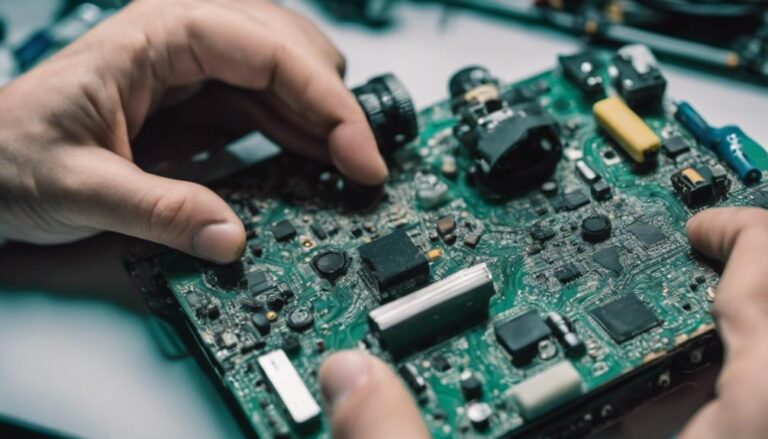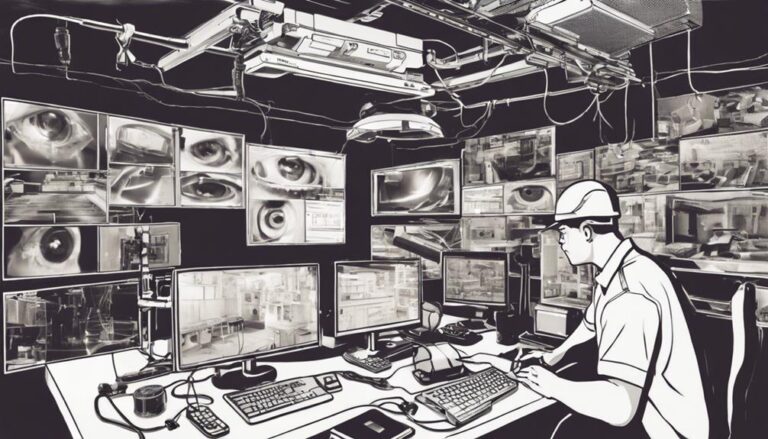To connect your wireless CCTV camera to your TV, start by placing the camera within range of your Wi-Fi router. Power it on and follow the manufacturer’s instructions to connect it to your Wi-Fi network through a mobile app or web interface. Next, grab an HDMI or AV cable to link the wireless receiver to your TV. Verify your TV is on the same Wi-Fi network as the camera and install any necessary apps. Finally, select the appropriate input on your TV, and you’ll see the live feed. Keep going to discover troubleshooting tips and ways to enhance your setup!
Understanding Wireless CCTV Cameras
Wireless CCTV cameras are revolutionizing home and business security by eliminating the hassle of tangled wires. With these cameras, you can enjoy the freedom to monitor your property without being tethered to a fixed location. Imagine placing cameras wherever you need them, whether it’s in your backyard, the front porch, or even inside your home, all without the worry of running cables through walls or ceilings.
These cameras use Wi-Fi or other wireless technology to transmit video feeds directly to your devices, giving you real-time access to your security footage. You don’t have to be a tech wizard to set them up; most models are designed for easy installation. Plus, you can view live streams or recorded footage from your smartphone or tablet, allowing you to keep an eye on things while you’re on the go.
In addition to their convenience, many wireless CCTV cameras come with advanced features like motion detection, night vision, and two-way audio. This means you can receive alerts when something’s happening and communicate directly through the camera. Embrace the freedom of wireless technology and enhance your security effortlessly!
Required Equipment for Connection
To connect your CCTV camera to your TV wirelessly, you’ll need a few essential pieces of equipment. First, you’ll require a wireless CCTV camera that fits your needs. Next, a wireless receiver is necessary to transmit the camera feed to your TV. Finally, verify you have the right cables and adapters for connecting the receiver to your TV.
Here’s a table to help you identify the required equipment:
| Equipment Type | Description | Purpose |
|---|---|---|
| Wireless CCTV Camera | A camera that transmits signals wirelessly | To capture video footage |
| Wireless Receiver | A device that receives the camera’s signal | To send the video feed to your TV |
| HDMI or AV Cables | Cables for connecting receiver to TV | To verify a clear and stable connection |
| Power Adapter | For the camera and receiver | To keep your equipment powered |
| TV with HDMI/AV Input | A television with input options | To display the live feed from the camera |
With this equipment in hand, you’re ready to move forward and enjoy the freedom of monitoring your space wirelessly!
Setting Up Your CCTV Camera
When setting up your CCTV camera, the first step is choosing the right model that suits your needs. Once you’ve selected a camera, you’ll need to establish a wireless connection to guarantee it communicates smoothly with your TV. Let’s go over how to make this setup as seamless as possible.
Choosing the Right Camera
Selecting the right CCTV camera is vital for effective surveillance. You want to guarantee your camera meets your specific needs and offers the freedom to monitor your space without limitations. Start by evaluating the area you aim to cover. Do you need an indoor or outdoor camera? Outdoor cameras should be weather-resistant and equipped with night vision for 24/7 surveillance.
Next, consider the resolution. Higher resolution cameras provide clearer images, which can be significant when identifying intruders or monitoring activity. Look for at least 1080p resolution for sharp visuals. Also, think about the field of view. A wider angle means you can cover more ground without needing multiple cameras.
Don’t forget about connectivity. While you’re planning to connect wirelessly to your TV, verify the camera can seamlessly integrate with your existing system. Some models even offer smart features, like motion detection and mobile alerts, granting you even more freedom to monitor from anywhere.
Lastly, check the brand’s reputation and customer reviews. Choosing a reliable camera will give you peace of mind and enhance your surveillance experience, letting you feel secure in your own space.
Wireless Connection Setup
After you’ve chosen the right CCTV camera for your needs, setting up a wireless connection is the next step to confirm seamless monitoring. Start by placing your camera within range of your Wi-Fi router. Make sure your TV is also connected to the same network for easy access.
Next, power on your CCTV camera and follow the manufacturer’s instructions to connect it to your Wi-Fi. Usually, this involves using a mobile app or web interface. Once it’s connected, you’ll need to link the camera to your TV.
Here’s a simple table to guide you through the key steps:
| Step | Action | Notes |
|---|---|---|
| 1. Choose Camera | Select a compatible wireless model | Check for TV compatibility |
| 2. Position Camera | Find a suitable location | Confirm Wi-Fi signal is strong |
| 3. Connect Wi-Fi | Use app or web interface | Follow prompts carefully |
| 4. Link to TV | Use HDMI or screen mirroring | Refer to your TV’s manual |
| 5. Test & Adjust | Check video feed on your TV | Make adjustments as needed |
Once everything’s set up, enjoy the freedom of monitoring your space wirelessly!
Configuring Wi-Fi Settings
Configuring Wi-Fi settings is essential for guaranteeing seamless connectivity between your CCTV camera and TV. First, grab your camera’s user manual, as it’ll guide you through the specific settings needed. You’ll usually find an option to access the camera’s interface either through a mobile app or a web browser.
Once you’re in, look for the Wi-Fi settings section. Here, you’ll need to select your home Wi-Fi network from the list. Make sure to enter your Wi-Fi password accurately—one wrong character can mess up the connection. If there’s an option for DHCP, it’s best to enable it, as this will automatically assign an IP address to your camera.
After you’ve saved the settings, reboot the camera to guarantee it properly connects to your network. You may want to check the connection status through the app or interface to confirm everything’s working smoothly. With the right settings configured, you can enjoy the freedom of accessing your CCTV feed from your TV without any hassle. This step is key, paving the way for the next phase of connecting your camera to your television.
Connecting to Your TV
With your CCTV camera successfully connected to your Wi-Fi network, the next step is linking it to your TV. This process is pretty straightforward and gives you the freedom to monitor your space right from the comfort of your couch. Here’s how to do it:
- Check your TV’s compatibility: Confirm your TV supports wireless streaming or has the appropriate app installed.
- Download the necessary app: If your camera requires a specific app, grab it from your TV’s app store.
- Connect your TV to the same Wi-Fi network: Make sure your TV is connected to the same Wi-Fi network as your CCTV camera. This is essential for seamless streaming.
- Follow the app instructions: Open the app and follow the prompts to link your CCTV camera. This usually involves selecting your camera from a list and entering any required credentials.
Once you’ve completed these steps, you should be able to view your CCTV feed on your TV. Enjoy the peace of mind that comes with having your surveillance at your fingertips, allowing you to stay aware of what’s happening around you!
Testing the Connection
Now that you’ve linked your CCTV camera to your TV, it’s time to test the connection. Grab your remote and switch on your TV. Navigate to the input source where your camera is connected, whether it’s HDMI, AV, or another option. You should see the live feed from your camera on the screen. Move around and check if the picture updates smoothly.
To help you keep track of your testing process, here’s a simple table:
| Test Action | Result Expected | Action if Failed |
|---|---|---|
| Power on the TV | TV displays camera feed | Check connections |
| Switch to correct input | Live feed visible | Change input source |
| Move in front of camera | Feed updates in real-time | Check camera position |
| Adjust camera angle | Clear view of area | Reposition camera |
If everything’s working as it should, you’re good to go! Enjoy the freedom of monitoring your space effectively. Just remember, a good setup guarantees you can keep an eye on what matters most.
Troubleshooting Common Issues
When you’re setting up a wireless connection for your CCTV camera to your TV, it’s not uncommon to run into a few hiccups. Don’t worry; troubleshooting these issues can be straightforward. Here are some common problems you might face and how to fix them:
- Poor Signal Strength: Verify your camera and TV are within the recommended range of your wireless router. Walls and interference from other devices can weaken the signal.
- Incorrect Network Settings: Double-check that both devices are connected to the same Wi-Fi network. Sometimes, a simple mix-up can cause connection problems.
- Outdated Firmware: Make certain your camera and TV have the latest firmware updates. This can resolve compatibility issues and improve performance.
- Power Issues: Confirm that both your CCTV camera and TV are powered on and functioning properly. Unplugging and plugging them back in can help reset the connection.
Enhancing Your Security Setup
A robust security setup can greatly enhance your peace of mind. By integrating your CCTV cameras with your TV wirelessly, you’re not just keeping an eye on your property; you’re taking control of your safety. Start by ensuring your cameras are strategically placed to cover key areas like entrances and driveways, allowing you to monitor potential threats effectively.
Next, consider adding motion sensors or alarms that sync with your CCTV system. When a camera detects movement, you’ll receive alerts directly on your TV. This capability gives you real-time awareness of your surroundings, empowering you to respond quickly if needed.
Don’t overlook the importance of high-quality cameras. Opt for models with night vision and high resolution to capture clear images, day or night. Wireless connectivity is vital, so choose cameras that offer a strong signal and reliable performance.
Frequently Asked Questions
Can I Connect Multiple CCTV Cameras to One Tv?
Sure, you can connect multiple CCTV cameras to one TV, but it requires the right setup. Think of the freedom to monitor all angles at once, enhancing your security without compromising your space or convenience.
What Range Should I Expect From My Wireless CCTV Camera?
You can expect a range of about 100 to 300 feet for your wireless CCTV camera, depending on obstacles and interference. For ideal performance, try to minimize barriers between the camera and receiver.
Will Weather Conditions Affect My Wireless CCTV Camera’s Performance?
Weather conditions can greatly impact your wireless CCTV camera’s performance. While you might crave uninterrupted surveillance, rain and wind can distort signals. Embrace the freedom of monitoring, but be mindful of nature’s unpredictability affecting your setup.
How Often Should I Update My CCTV Camera Firmware?
You should update your CCTV camera firmware regularly, ideally every few months or whenever the manufacturer releases updates. Staying current helps guarantee peak performance, security enhancements, and new features, giving you peace of mind and freedom.
Can I Access My CCTV Camera Remotely While Connected to the Tv?
Yes, you can access your CCTV camera remotely while it’s connected to the TV. You’ll enjoy the freedom of monitoring your space anytime, anywhere, simplifying your security and keeping your loved ones safe.



